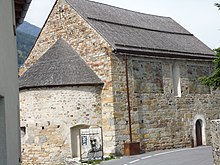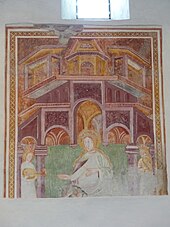St. Markus (Laas)
St. Markus (also called St. Marx ) is a small former church building in the village of Laas in South Tyrol and is one of the four oldest churches in Laas. It is located on the northern bank of the Adige and in the immediate vicinity of the parish church of St. John the Baptist , from which it is separated by a road. It was the only church in South Tyrol that was consecrated to St. Mark .
history
The church was mentioned for the first time in 1323, the State Monuments Office dates the construction time to 1120 to 1130. Who commissioned the construction of the church and to whom it owes its patronage has not yet been clarified.
The land register books of the parish show that the Church as an ossuary (crypt) of Laas has served. For the year 1496 it is noted that " Bläs Valrayrers Erbn " annually had to pay three Müttli rye and one and a half Müttli barley " in the painhauss or totn grufft to read " interest from the Waalacker. Furthermore, it says: " Cristänli sol every Saturday night and all our dear women night and all twelve pottn nights over Jar in the painhauss to Sandt Johannsn to read honest and innocent lighting as it is from ancient times pfant is ain field called the light field .. . ". In the land register of 1586 there is an entry that Sigmundt Platzer, as the owner of the " Liechtacker located on Creutz ", is obliged to continue the custom of lighting the ossuary near St. Johannes on the " pre-malted " evenings and nights throughout the year. If the designation "at St. Johannes" or "to St. Johannes" was used here, it became more specific in 1753, since it was stated more precisely that " the Painhauß or death crypt under Sanct Marxkürchen " was to be illuminated. It has always been the responsibility of the owner of the said field, which was three mothers in size, from time immemorial. Since this field is in danger of the Lahns , the light on the “User Frau Evenings” on the “Apostle Evenings” could not be lit. Now, however, the current owner has to provide the Lich on the specified days and to maintain it “ radically and safely ”.
According to Talman Planth's chronicle from 1777, St. Marx was partially destroyed in the Engadine War , but was soon rebuilt. According to the visitation files from 1638, it can be seen that the church was consecrated anew in 1502 by the Chur bishop Stephan with two altars in the choir and a crypt. The episcopal records note:
"Sacellum S. Marci super cryptum amplum valde et altum, tabolato et uno altari constat, 2 sunt destructa, qui amodum antiquum dedificata obscurum sacellum rediderunt."
“ The Church of St. Mark is very spacious and high, above a crypt, it consists of one floor and an altar, two of which have been demolished. "
During the reign of Emperor Joseph II. , Between 1782 and 1787, monasteries were abolished, and “superfluous” side churches - including St. Marx - were profaned and used for other purposes.
Until 1785 the church was still in its original use, since up to this year still in the parishes beyond the respective obligation on Sundays and public holidays for the Christmas day " with the beginning of the day a St. Office in the S. Marcus Churches "is mentioned, further that" at the beginning of the day a St. Office in the S. Marcus Churches "is held and" after the office in the parish church has ended, the Frueh Möß which the respective early Möß owes both to hold ". “ The Sunday after S. antoni abbt is the parish fair at S. Marcus, a pastor from Schlander's office and Prödig has to hold the previous evening in the s. Marcus Kirchen is held the Vespers by a respective pastor, but with those that he has to enjoy with the priests and lords of Silandro, the priest's meal ”. After 1786 the church is no longer mentioned in this regard.
The building was then used as a storage room for church equipment. An inventory list of the parish church from 1822 shows flags, a sky for processions, candlesticks, mass dresses and other utensils.
During the renovation of the parish church of St. Johannes in 1850/52, the services were held again in St. Marx.
The request of the Imperial and Royal District Office in Bozen from February 1, 1747 to the Prince-Bishop's Ordinariate in Trento to demolish the building was granted, but ultimately not carried out because the expansion of St. John's Church had to demolish its stable and barn and replace it with the former St. Marx Church was envisaged.
In 1880 the "kk technical school for stone processing", founded in 1879 and later known far beyond the borders of Tyrol , was housed in the building. For this purpose, a false ceiling was drawn in and several openings were broken, which were provided with windows (so-called studio windows). After the stonemason school was relocated to Bozen in 1911, the primary school was housed here, which was also used as a rehearsal room for the local music band. For a long time, the ground floor was where the milk collection point and an alpine dairy were.
Today the building is used for social purposes.
Building
The east-west direction was only roughly adhered to during the construction, the axis through the relatively high nave runs from west-northwest to east-southeast. The masonry consists partly of hewn, large cuboids, the arrangement of which is very regular. This is red sandstone from Allitz , Lasa marble was only used in small quantities. The semicircular apse is on the eastern front side, the entrance was originally in the western front side, but was moved to the rear of the northern side wall. Inside the towerless building there was a crypt that served as an ossuary for a long time .
During the extensive restoration work in 2000/2007, the foundation walls of a previous church from the 7th century, which had a total width of six meters, were found. The original screed and the stone floor could be exposed.
Inside, fragments of Gothic frescoes were exposed, depicting the enthroned Mother of God , flanked by angels making music. The fresco is surrounded by an architectural frame. They are dated to around 1400. The quality of the frescoes is rated as high. Small remains of paint from late medieval wall paintings could also be exposed on the south wall. The apse was restored to its original shape and access to the crypt was restored.
Furthermore, the studio windows were properly closed again (they are indicated today by glass panes attached to the wall).
In the south, the church building is connected by wooden balustrades to a building that was mentioned as early as 1496 as “hofstat unter sand Marxkyrchn” . In 1695 a Hans Sarz from this house was liable for tax. Later it is called the “butcher 's dwelling which with its stable and barn towards midnight” (ie towards the north) “adjoins the St. Mark's Church”.
Individual evidence
- ↑ Gertraud Laimer Tappeiner: Churches of Laas, Eyrs, Tschengls and Tanas. Ed. Parish of Laas, Verlag Tappeiner, Lana 2011, p. 48.
- ↑ So the translation in the source
- ↑ January 17th
literature
- Ascended to Heaven - Alpine Romanesque Road. Information brochure of the holiday region Obervinschgau Mals / Burgeis-Schluderns-Glurns, undated
- Gertraud Laimer Tappeiner: Churches of Laas, Eyrs, Tschengls and Tanas. Ed. Pfarre Laas, Verlag Tappeiner, Lana 2011, pp. 48–53.
- Franz Waldner, Harbert Raffeiner, Hermann Schönthaler, Isidor Schönthaler, Wilfried Stimpfl, Johann E. Thumler, Manfred Zangerle "Houses from Laas, Tschengls, Eyrs, Tanas, Alitz" Verlag Tappeiner Lana 1990 pp. 61–62.
Web links
- Entry in the monument browser on the website of the South Tyrolean Monuments Office
Coordinates: 46 ° 37 ′ 0.4 ″ N , 10 ° 41 ′ 54.9 ″ E




